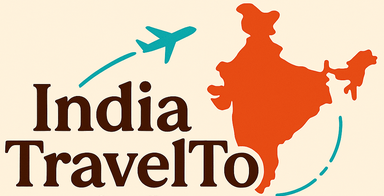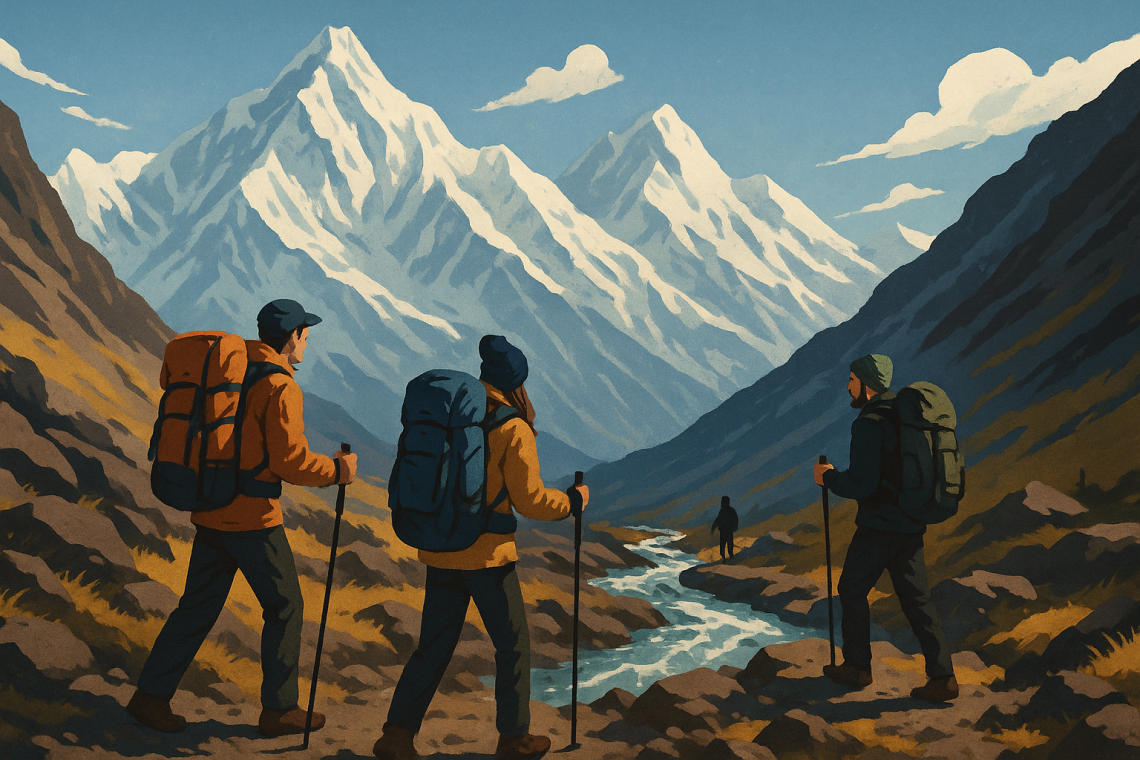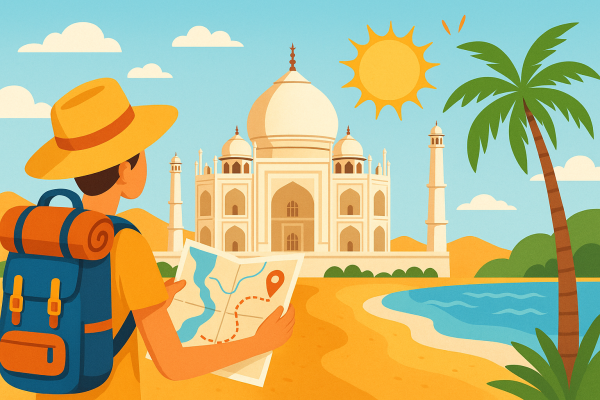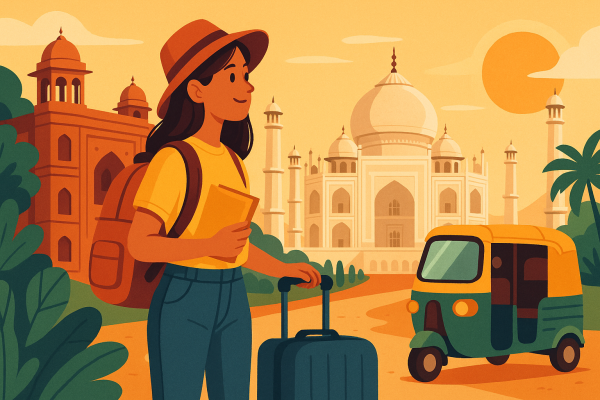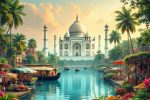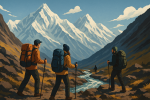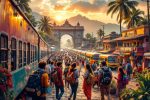How to Travel to India’s Himalayas: Trekking and Adventure Tips
Embark on an unforgettable adventure in the Indian Himalayas, home to breathtaking treks ranging from beginner-friendly trails to challenging climbs. Discover iconic destinations like Ladakh, Uttarakhand, and Himachal Pradesh, or explore offbeat gems in Darjeeling and Sikkim. Plan your ideal trek with our comprehensive guide, covering everything from choosing the right destination and understanding trek grading systems to essential packing lists and safety considerations. Start your Himalayan journey today!
Important information
- Popular trekking regions in the Indian Himalayas include Ladakh (“Land of High Passes”), Uttarakhand (“Abode of Gods”), and Himachal Pradesh, each offering unique landscapes and trek difficulties.
- Plan your trek during the optimal seasons: Summer (mid-April to mid-June) for pleasant weather and lush scenery, or Autumn (mid-September to mid-November) for crisp air and clear views.
- Essential preparation includes physical conditioning (cardio and strength training), acclimatization to high altitudes, and obtaining necessary permits and a valid Indian visa.
- Pack appropriate gear, including sturdy hiking boots, warm layers, a first-aid kit, and a hydration system. A reliable backpack is crucial for carrying these essentials.
- Comprehensive travel insurance is vital, covering medical emergencies (including helicopter evacuation), trip cancellations, and high-altitude trekking. Develop and share a detailed evacuation plan.
Understanding the Indian Himalayas
The Himalayas, renowned for their breathtaking beauty and spiritual significance, attract adventurers and trekkers from around the world. India is home to roughly half of this colossal mountain range, which spans five countries. While the challenging terrain presents a formidable obstacle, the rewarding experience creates an unforgettable adventure for trekking enthusiasts.
Major Trekking Hubs: Ladakh, Uttarakhand, and Himachal Pradesh
Ladakh, located in the Indian Himalayas, is known as the “Land of High Passes”. It offers diverse trails and stunning landscapes, making it an ideal destination for trekkers. Uttarakhand, also known as “Devabhumi” or “Abode of Gods,” combines spirituality and scenic beauty. It attracts trekkers with its pilgrimage routes and challenging terrains. Himachal Pradesh, famous for its hill stations and apple orchards, provides a variety of treks amidst picturesque valleys and breathtaking snow-capped peaks. These treks range from easy walks to demanding climbs, catering to different experience levels.
Offbeat Trails: Exploring Darjeeling and Sikkim
Embark on an unforgettable Himalayan adventure with treks in Darjeeling and Sikkim. Sikkim, a gateway to India’s northeast, seamlessly blends cultural immersion with thrilling yet accessible adventures. The Darjeeling, Sikkim & Singalila Ridge trek is perfect for first-time trekkers, offering a unique combination of vibrant local traditions and breathtaking mountain views.
Choosing the Right Trekking Destination
Plan your Himalayan adventure in India’s majestic mountains. There’s a trek for every skill level, from beginner-friendly routes in the foothills to challenging climbs. Treks are graded by difficulty, considering altitude and terrain. Here are some popular options:
Unique Treks
- Markha Valley Trek: experience diverse landscapes.
- Chadar Frozen River Trek: journey across a frozen river.
Popular Treks
- Rupin Pass Trek.
- Kuari Pass Trek.
- Kedarkantha Trek.
Beginners can find suitable treks in the Himalayan foothills.
Popular Treks: Markha Valley and Chadar Frozen River
The Markha Valley trek is a Ladakh favorite, beloved for its breathtaking scenery and ideal for those new to the region’s trekking scene. For a unique winter adventure, consider the Chadar Frozen River trek, a journey across the frozen Zanskar River’s remarkable icy expanse. This trek requires meticulous planning and serious preparation due to the potentially dangerous conditions posed by the extreme cold and icy terrain.
Understanding Trek Grading Systems
Trek grading systems categorize hikes by difficulty, considering factors like duration, altitude gain, terrain, remoteness, and accommodation. These systems are valuable tools that help trekkers choose adventures that match their fitness level and experience. However, grading systems can vary by region. For example, the Himalayas use unique grading systems. Trekkers planning a Himalayan trek should research these specific difficulty levels for a safe and enjoyable experience.
Key Considerations for Trekking Adventures
Planning your Indian trekking adventure? Here’s what you need to know:
Documentation
- Check visa requirements based on your nationality.
- Secure necessary trekking permits in advance.
- Pack essential documents: passport, visa, and travel insurance.
- Carry helpful resources: guidebooks and maps.
Essentials
- Prepare a basic first-aid kit.
- Remember that cash is preferred in remote areas.
Spring (March-May)
Generally offers pleasant trekking conditions.
Summer (June-August)
Monsoon season in many areas.
Autumn (September-November)
Generally offers pleasant trekking conditions.
Winter (December-February)
Higher altitudes are blanketed in snow and ice.
Research your specific route to determine the optimal trekking time. Some treks are best enjoyed in spring, while others are more suitable for autumn. Consider the varying weather conditions at different elevations.
Visa Requirements and Travel Guide Essentials
Foreign nationals, including Overseas Citizens of India (OCI) cardholders, must have a valid passport and Indian visa. Apply for your visa in advance through the Indian visa website. A comprehensive travel guide can also assist with understanding permit requirements for specific trekking areas.
Best Time to Visit for Trekking
For an unforgettable Himalayan trek, plan your adventure around the best seasons: summer (mid-April to mid-June) or autumn (mid-September to mid-November).
Summer offers pleasant weather and vibrant landscapes, bursting with lush greenery.
If you prefer crisp air, thinner crowds, and breathtakingly clear views, autumn might be ideal.
Each season presents its own unique charm, so choose the one that best suits your preferences.
Preparing for a Trekking Adventure
Preparing for a Himalayan trek requires focus on fitness and packing. Begin with regular cardio, such as a 45-minute jog. Incorporate strength training with squats and lunges. Practicing with a weighted backpack simulates actual trekking conditions.
Fitness Preparation
- Start with regular cardio, like a 45-minute jog.
- Include strength training exercises, such as squats and lunges.
- Practice with a weighted backpack to simulate actual trekking conditions.
Essential Packing List
- A sturdy backpack.
- Reliable hiking boots.
- Quick-drying clothes and warm layers.
- A sleeping bag.
- A hydration system.
- A first-aid kit, sunscreen, and a camera.
Check with your tour operator for any specific gear requirements. With proper packing and physical preparation, your trek will be safer, more enjoyable, and ultimately a truly memorable experience.
Training and Physical Fitness
Preparing for a Himalayan trek involves key steps to ensure you’re physically and mentally ready for the challenge. Regular walks are crucial for building stamina and resilience. Joining local walking groups offers additional benefits, such as improved endurance and increased confidence. This preparation will prove invaluable for your upcoming Himalayan adventure.
Packing Essentials: Clothing and Gear
Pack for fluctuating weather conditions with adaptable layers. These include base layers, a fleece jacket, insulated outerwear, and waterproof gear for comfort and protection. Durable hiking boots with good ankle support are essential for navigating varied terrain. Choose a comfortable backpack and pack it strategically, ensuring it’s the right size for your needs. Essential gear includes trekking poles for stability, a headlamp for low-light conditions, a first-aid kit, and a water purification system or reusable bottles. For navigation, consider a map and compass or a GPS device to stay on course.
Logistical Planning for Trekking
Organized Treks
Organized treks offer the convenience of having all details handled for you. These details include permits, lodging, and porters, simplifying your trekking experience.
- Permits and lodging are arranged.
- Porters are provided for carrying gear.
- Simplified planning reduces pre-trek stress.
Independent Adventures
Independent adventures provide greater freedom to chart your own course. This freedom comes with the responsibility of increased planning and self-reliance.
- Design your own route for a personalized experience.
- Set your own pace and explore at your leisure.
- Enhanced self-reliance builds confidence and skills.
Tour operators and trekking agencies play a vital role in organized treks. They offer local expertise, logistical support, and enhanced safety, ensuring a smoother experience. Selecting a reputable agency is essential for a positive trekking experience.
- Local expertise provides valuable insights into the region.
- Logistical support streamlines transportation and accommodation.
- Enhanced safety measures minimize risks during the trek.
- Equipment rentals offer access to necessary gear.
Organized Treks vs. Independent Adventures
Organized Treks
Organized treks simplify the trekking experience. Permits, accommodations, and porters are handled for you, providing a sense of security, particularly for novice trekkers.
Independent Treks
Independent treks require you to manage all planning, navigation, and equipment. This self-reliance offers the freedom to personalize itineraries and explore less-frequented trails.
Role of Tour Operators and Trekking Agencies
Trekking agencies and tour operators handle all the logistics, from permits and transportation to accommodation and porters. They provide experienced guides familiar with the local terrain and culture, enhancing both safety and your understanding of the region. A reputable agency prioritizes your well-being and environmental responsibility, offering pre-trip briefings and ongoing support throughout your trek. Choosing a certified agency is crucial for ensuring adherence to safety standards and ethical practices, giving you peace of mind during your adventure. Here’s what a good trekking agency offers:
- Handles all logistics: permits, transportation, accommodation, and porters.
- Provides experienced guides: knowledgeable about the local terrain and culture, enhancing safety and understanding.
- Prioritizes well-being and environmental responsibility: offers pre-trip briefings and ongoing support.
- Ensures adherence to safety standards and ethical practices: provides peace of mind.
Health and Safety Considerations
Acclimatize properly, especially above 8,000 feet, to avoid altitude sickness. Common symptoms include headaches, nausea, and dizziness. Ascending slowly allows your body to adapt to the thinner air. Schedule rest days, particularly after significant climbs.
Stay hydrated by drinking plenty of water. Avoid dehydrating substances like alcohol and caffeine. Diamox can help prevent altitude sickness, but consult a doctor beforehand.
Obtain travel insurance, especially for Himalayan treks. Ensure your policy covers emergencies, including medical expenses, helicopter evacuation, and trip cancellations. Choose a reputable insurer specializing in adventure travel.
Keep your policy accessible, both physically and digitally. Share it with your group and family. Inform your insurer of your trek plan, including dates and locations, to ensure full coverage.
Acclimatization and Altitude Sickness Prevention
Ascend gradually to adapt to high altitudes and minimize the risk of altitude sickness.
Incorporate buffer days into your itinerary for unforeseen weather and acclimatization.
Pay close attention to your body; headaches or nausea could indicate altitude sickness.
Prior physical conditioning enhances stamina and endurance, vital for challenging ascents.
Proper hydration and a balanced diet also aid acclimatization.
Pack sturdy boots and warm layers to handle fluctuating mountain conditions.
Mountain weather is notoriously unpredictable, and the right equipment offers crucial protection.
Be flexible and adapt your plans as needed, as even meticulous preparation can’t eliminate all altitude-related challenges.
Travel Insurance and Emergency Evacuation Plans
Planning a Himalayan trek? Travel insurance is a must, especially considering the high altitudes. Ensure your policy covers medical emergencies, including helicopter evacuations and trip cancellations, as well as lost baggage. A detailed evacuation plan is crucial. This plan should outline communication protocols, emergency contacts, nearby medical facilities, helicopter landing zones, and potential evacuation routes. Share this plan with your trekking group and family back home. Verify your insurance covers your trek’s specific altitude for a safe and secure adventure. Here’s a step-by-step guide to help you prepare:
Secure comprehensive travel insurance. Ensure it covers medical emergencies (including helicopter evacuations), trip cancellations, and lost baggage.
Develop a detailed evacuation plan. Outline communication protocols, emergency contacts, nearby medical facilities, helicopter landing zones, and potential evacuation routes.
Share your plan. Distribute your evacuation plan to your trekking group and family back home.
Verify altitude coverage. Confirm your insurance covers the specific altitude of your trek.
